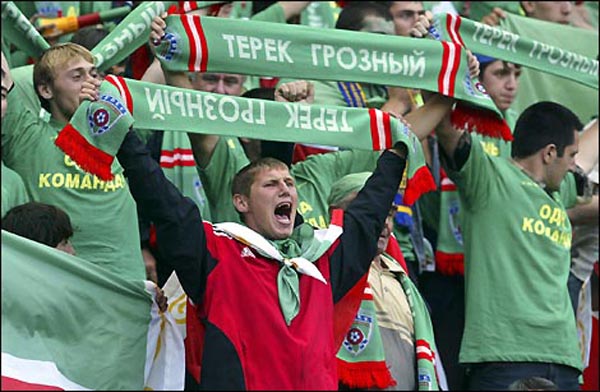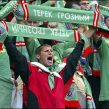
Soccer in the North Caucasus Is More Than Just Sport
Publication: Eurasia Daily Monitor Volume: 8 Issue: 184
By:

It is not an accident that the city of Grozny’s annual festival is held on October 5, Ramzan Kadyrov’s birthday. This year, a building complex nicknamed Grozny-City will be inaugurated on October 5. It consists of five multi-storey buildings, including 45-story, 30-story and 18-story residences, a 30-story five-star hotel, a business center with a helipad on the top and a two-story underground parking (www.youtube.com/watch?v=ZtiDGsJuR2Y). Grozny currently has the tallest building in the North Caucasus – that building is also the biggest clock tower in Russia, with a clock 14 meters in diamater and a hand that is 7.5 meters long (www.youtube.com/watch?v=L2jnsxwSjSs).
Apart from these buildings, Grozny also has the largest hospital in the North Caucasus. Grozny’s main avenue, which was named after Ramzan Kadyrov’s father, is being “opened” for the sixth time. The city already has the biggest mosque in Europe, again named after Ramzan Kadyrov’s father. There are fountains around the city that replicate those in Nice, Monaco and other glamorous places. There is the ultra-modern Ahmat-arena stadium, also named after Ramzan’s father, which trumps its rivals in the North Caucasus.
Acquiring a first-class soccer team was not the last task on Razman Kadyrov’s checklist. Meanwhile, the local soccer team, Terek, practices its skills not at the best stadium in the North Caucasus in Grozny, but in Kislovodsk, in the neighboring Stavropol region. Kadyrov has been very upset about the team’s failure to place among the top five teams in the Russian championship. That would have allowed Terek to take part in international games – the Union of European Football Associations (UEFA) Cup. However, the situation cannot be changed by administrative means, as Terek lags behind, occupying one of the last positions in the national championship. In the past three years, it has not climbed up higher than 10th place in the Russian premier league soccer championship, in which 16 soccer teams participate.
It is noteworthy that six soccer teams out of those 16 come from the North Caucasus, and that three of the six come from the North Caucasian ethnic republics – Anzhi of Dagestan, Terek of Chechnya and Spartak-Nalchik of Kabardino-Balkaria. Next year, Alania of North Ossetia will most naturally be added to the list. In neighboring Dagestan, one of the wealthiest people in Russia, Suleiman Kerimov, bought the local Anzhi soccer team and went on to acquire the best soccer players in the world, paying them tens of millions dollars. Soccer is becoming not simply a sporting event, but a commercial project of the richest Russians. In a volatile region like the North Caucasus, soccer is also becoming a propaganda tool. Such famous soccer players as Moubarak Boussoufa, Roberto Carlos and Samuel Eto’o, who play for Anzhi (https://fananji.com), or coach Ruud Gullit, who recently left Terek, as well as former Terek player Héctor Bracamonte create an image of the North Caucasus that is recognizable by hundreds of millions of soccer fans. Gullit’s words, that “he painted Terek on the soccer map of the world” (www.euro-football.ru/article/29/802829), is not far from reality.
It was for the same purpose that famous soccer players of 1990s, led by the eminent Diego Maradona, came to Grozny to play in a game and to unceasingly praise the republic while surrounded by armed guards (https://inosmi.ru/social/20110512/169314931.html). The game was organized by the Chechen businessman Bulat Chagaev, who has commercial interests in Switzerland. Chagaev was expected to finance Terek, bypassing the republican budget, as intended by Ramzan Kadyrov. However, having not lived up to the regional leadership’s expectations, Chagaev had to leave Chechnya this past summer.
There is a reverse side of the soccer phenomenon. By providing the North Caucasian soccer teams with opportunities to progress in the Russian championship, Moscow is creating problems for itself. Hatred toward the North Caucasians among ethnic Russians is growing fast precisely in the soccer related sphere. Russian soccer fans organized pogroms against Caucasians on Moscow’s Manezh square near the Kremlin in December 2010 (https://lenta.ru/story/manezhnaya/). Soccer fans have initiated a number of anti-Caucasian rallies in Moscow and St. Petersburg. North Caucasians themselves increasingly realize they are not considered citizens of Russia, being subjected to vigorous security checks at Russian airports as if they were foreign visitors in the country (www.pravda.ru, September 30).
At the same time, news of bomb attacks arrives from the North Caucasus almost on a daily basis (RIA Novosti, October 1). The ethnic Russian population in the North Caucasus continues to leave the region (www.km.ru/v-rossii, October 1). And the Russian government has admitted that the number of insurgents in the region has not changed in recent years (www.gazeta.ru, September 30).
Soccer has become a propaganda tool played by the Chechen authorities and Moscow, who are eager to portray Chechnya as a peaceful republic more concerned about sport than security. By inviting foreign soccer players to play in Chechnya for money that even Westerners cannot afford, the government is attempting to create a new image for the region on the eve of the Sochi Olympics in 2014. It is part of the Kremlin’s attempt to use flashy and expensive programs to try to hide the problem of armed resistance by Islamic and nationalist radicals in the region.




